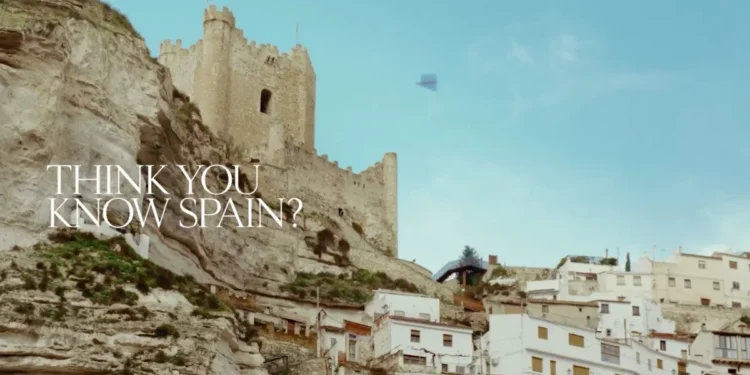Alberto Barciela
In response to current affairs that demand it, it seems appropriate to focus Spain’s international tourism promotion on a three-pronged axis grounded in fashionable concepts such as economic, social, and environmental sustainability. What’s more questionable is doing so under a slogan—perhaps here it’s better not to call it a slogan—like “Think You Know Spain? Think Again”, which, while translating accurately as “Think you know Spain? Think again,” feels rather restrictive in terms of audience. It doesn’t seem aimed at attracting new travelers, but rather at encouraging repeat visitors to switch their options.
This, they say, is Turespaña’s first international tourism campaign, and it’s claimed to be focused on inland Spain and sustainable tourism, as if previous efforts hadn’t emphasized nature, rural tourism, or the Camino de Santiago—the very paradigm of institutional coordination and of benefiting diverse geographic areas—urban, rural, sunlit, or sandy—with an undeniably rich cultural foundation. Nothing new under the sun: a beautiful collection of images, but a blurred core, perhaps caused by poorly understood political demands or born from uninspired creativity burdened by a large budget—pressuring decision-makers to push forward at the expense of the country’s longstanding golden goose located in high-demand territories, which can radiate benefits across the entire nation.
It is conceivable—though difficult to imagine—that someone visiting the Prado or the Guggenheim, or Barcelona or Málaga, or the Canary Islands or the Balearics, or Andalusia or the Levant, would end up in Albacete or Teruel, even in Badajoz with its own distinctive beauties. What seems impossible is the reverse. A pilgrim in Santiago de Compostela, under sun or rain, may enhance their experience by attending the Xinzo da Limia carnival, visiting a winery in A Rúa de Petín, or stopping at a spa as part of well-designed train+bus routes—but imagining a Japanese tourist—excluding camelias enthusiasts—going to rural Galicia only to circle Lugo’s walls, celebrate Christmas in Vigo, or visit A Coruña is far-fetched. A different and magnificent Spain exists, but most foreign tourists primarily seek to replicate our relaxed, safe, close-knit Mediterranean lifestyle, underpinned by unrivaled value for money.
Instead of building the house from the roof, we should encourage Spaniards to appreciate what’s close by, to swap the Caribbean for the Canary Islands, the Balearics, or the Mediterranean. Or to rediscover the depopulated Spain that has already benefited from rural tourism plans, monument restorations, the cleaning of rivers and reservoirs with beaches, hunting and fishing, rehabilitation of historic centers and landmarks—and countless public aid programs at European, national, regional, and provincial levels—tied to a remarkably ambitious infrastructure modernization plan.
Jordi Hereu—this campaign represents a bid to attract international tourists traveling off-season or to lesser-known destinations. It’s a worthwhile goal, and he is among the most diligent, serious, and effective politicians—he already demonstrated this at HISPASAT—but this rocket could veer off course or implode if the engineers misplace its thrusters. The country’s external strength lies in well-defined concepts: sun and beach, competitive prices, safety, lifestyle, service—and iconic assets: art, monuments, museums, major sports teams and triumphant individuals, traditional centuries‑old festivals like Carnivals, Semana Santa, San Fermín, Feria de Abril, etc.; forests, snow, unique villages, landscapes of sublime beauty… No one visits Spain—especially from distant countries—for some lost Mudéjar arch in a small Andalusian village when they can visit the Alhambra.
It’s ironic that the push to promote emptied‑out Spain coincides with the removal of train stops in inland stations. Something’s amiss in the coordination between tourism and transport. Doing things well in appearance does not guarantee the best results. And this could have serious consequences when referring to the country’s leading industry—the one that generates the most wealth and employment. Perhaps Turespaña shouldn’t—or perhaps it should—address issues like workforce training, airport operations and facilities, sufficient customs staffing, streamlined procedures, polite multilingual service, plentiful efficient taxis, and intermodal connections… but if all these elements worked properly, they would help spread word‑of‑mouth about the wonderful experience of visiting this unique country, which can operate twelve months a year and must find ways to prevent 90% of Spanish tourism from concentrating in just a few dates and locations. And all this under the umbrella of an increasingly professionalized sector, with better entrepreneurs and the greatest willingness to be effectively served by their public counterparts.
We have everything under the sun. There’s no need to overthink it—we just need to promote it with real intelligence. Turespaña has always been highly effective, even if it occasionally errs or fails to invite—or be attended by—the most representative associations. Together, once we review the formal lists, the media, and the objectives, we can reach for the stars—but first we must reconcile, coordinate, clarify goals, and understand the market.
If we are—or are about to become—world leaders, what’s not working? Think it over, and you may uncover more emptiness beneath the veneer. Don’t be fooled, Mr. Hereu: the destination must be smart, but to get to Castelldefels, you must go through Barcelona. No ifs, no buts.







